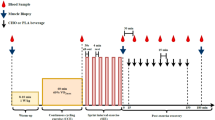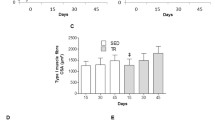Abstract
The 70-kDa heat shock protein (HSP70) is a ubiquitous molecular chaperone which is highly inducible by cellular stress such as exercise. To investigate the role of muscle glycogen content on the HSP70 expression, muscle glycogen was manipulated by consumption of either water (H2O) or a carbohydrate-enriched diet (CHO) during recovery from 4 h of glycogen-depleting cycling exercise in fourteen elite endurance athletes. Muscle biopsies were obtained pre- and post-exercise, and after 4 and 24 h of recovery, and analyzed for HSP70 mRNA expression, as well as HSP70 protein expression and muscle glycogen within the same skeletal muscle fibers using immunohistochemistry. Exercise reduced glycogen by 59 ± 10% (P < 0.0001). After 4 h of recovery, glycogen approached resting levels in the CHO group (86% of pre, P = 0.28) but remained suppressed in the H2O group (41% of pre, P < 0.001) (group × time interaction: P = 0.002). Importantly, both the HSP70 mRNA (+ 1.6-fold (+ 0.28/− 0.24), P = 0.02) and protein expression (+ 147 ± 99%, P < 0.0001) was substantially increased after exercise and remained elevated in both groups after 4 h of recovery, despite clear differences in muscle glycogen content. Thus, muscle glycogen content was not related to the variation in single fiber HSP70 expression at the 4-h time-point (r2 = 0.004). In conclusion, muscle HSP70 expression remained elevated during recovery from prolonged exercise in highly trained skeletal muscle, irrespective of muscle glycogen availability.





Similar content being viewed by others
References
Bartlett JD, Hwa Joo C, Jeong TS, Louhelainen J, Cochran AJ, Gibala MJ, Gregson W, Close GL, Drust B, Morton JP (2012) Matched work high-intensity interval and continuous running induce similar increases in PGC-1α mRNA, AMPK, p38, and p53 phosphorylation in human skeletal muscle. J Appl Physiol (bethesda, Md: 1985) 112(7):1135–1143. https://doi.org/10.1152/japplphysiol.01040.2011
Chung J, Nguyen AK, Henstridge DC, Holmes AG, Chan MH, Mesa JL, Lancaster GI, Southgate RJ, Bruce CR, Duffy SJ, Horvath I, Mestril R, Watt MJ, Hooper PL, Kingwell BA, Vigh L, Hevener A, Febbraio MA (2008) HSP72 protects against obesity-induced insulin resistance. Proc Natl Acad Sci USA 105(5):1739–1744. https://doi.org/10.1073/pnas.0705799105
Cumming KT, Paulsen G, Wernbom M, Ugelstad I, Raastad T (2014) Acute response and subcellular movement of HSP27, alphaB-crystallin and HSP70 in human skeletal muscle after blood-flow-restricted low-load resistance exercise. Acta Physiol (Oxf) 211(4):634–646. https://doi.org/10.1111/apha.12305
Febbraio MA, Koukoulas I (2000) HSP72 gene expression progressively increases in human skeletal muscle during prolonged, exhaustive exercise. J Appl Physiol (bethesda, Md: 1985) 89(3):1055–1060. https://doi.org/10.1152/jappl.2000.89.3.1055
Febbraio MA, Ott P, Nielsen HB, Steensberg A, Keller C, Krustrup P, Secher NH, Pedersen BK (2002a) Exercise induces hepatosplanchnic release of heat shock protein 72 in humans. J Physiol 544(3):957–962. https://doi.org/10.1113/jphysiol.2002.025148
Febbraio MA, Steensberg A, Walsh R, Koukoulas I, van Hall G, Saltin B, Pedersen BK (2002b) Reduced glycogen availability is associated with an elevation in HSP72 in contracting human skeletal muscle. J Physiol 538(Pt 3):911–917. https://doi.org/10.1113/jphysiol.2001.013145
Febbraio MA, Mesa JL, Chung J, Steensberg A, Keller C, Nielsen HB, Krustrup P, Ott P, Secher NH, Pedersen BK (2004) Glucose ingestion attenuates the exercise-induced increase in circulating heat shock protein 72 and heat shock protein 60 in humans. Cell Stress Chaperones 9(4):390–396
Fiorenza M, Gunnarsson TP, Hostrup M, Iaia FM, Schena F, Pilegaard H, Bangsbo J (2018) Metabolic stress-dependent regulation of the mitochondrial biogenic molecular response to high-intensity exercise in human skeletal muscle. J Physiol 596(14):2823–2840. https://doi.org/10.1113/jp275972
Gejl KD, Hvid LG, Frandsen U, Jensen K, Sahlin K, Ortenblad N (2014) Muscle glycogen content modifies SR Ca2+ release rate in elite endurance athletes. Med Sci Sports Exerc 46(3):496–505. https://doi.org/10.1249/mss.0000000000000132
Gupte AA, Bomhoff GL, Swerdlow RH, Geiger PC (2009) Heat treatment improves glucose tolerance and prevents skeletal muscle insulin resistance in rats fed a high-fat diet. Diabetes 58(3):567–578. https://doi.org/10.2337/db08-1070
Henstridge DC, Bruce CR, Drew BG, Tory K, Kolonics A, Estevez E, Chung J, Watson N, Gardner T, Lee-Young RS, Connor T, Watt MJ, Carpenter K, Hargreaves M, McGee SL, Hevener AL, Febbraio MA (2014) Activating HSP72 in rodent skeletal muscle increases mitochondrial number and oxidative capacity and decreases insulin resistance. Diabetes 63(6):1881–1894. https://doi.org/10.2337/db13-0967
Henstridge DC, Febbraio MA, Hargreaves M (2016) Heat shock proteins and exercise adaptations. Our knowledge thus far and the road still ahead. J Appl Physiol (bethesda, Md: 1985) 120(6):683–691. https://doi.org/10.1152/japplphysiol.00811.2015
Hvid LG, Gejl K, Bech RD, Nygaard T, Jensen K, Frandsen U, Ortenblad N (2013) Transient impairments in single muscle fibre contractile function after prolonged cycling in elite endurance athletes. Acta Physiol (Oxf) 208(3):265–273. https://doi.org/10.1111/apha.12095
Jensen L, Gejl KD, Ortenblad N, Nielsen JL, Bech RD, Nygaard T, Sahlin K, Frandsen U (2015) Carbohydrate restricted recovery from long term endurance exercise does not affect gene responses involved in mitochondrial biogenesis in highly trained athletes. Physiol Rep. https://doi.org/10.14814/phy2.12184
Jevons EFP, Gejl KD, Strauss JA, Ortenblad N, Shepherd SO (2020) Skeletal muscle lipid droplets are resynthesized before being coated with perilipin proteins following prolonged exercise in elite male triathletes. Am J Physiol Endocrinol Metab. https://doi.org/10.1152/ajpendo.00399.2019
Khassaf M, Child RB, McArdle A, Brodie DA, Esanu C, Jackson MJ (2001) Time course of responses of human skeletal muscle to oxidative stress induced by nondamaging exercise. J Appl Physiol (bethesda, Md: 1985) 90(3):1031–1035. https://doi.org/10.1152/jappl.2001.90.3.1031
Kishor A, Tandukar B, Ly YV, Toth EA, Suarez Y, Brewer G, Wilson GM (2013) Hsp70 is a novel posttranscriptional regulator of gene expression that binds and stabilizes selected mRNAs containing AU-rich elements. Mol Cell Biol 33(1):71–84. https://doi.org/10.1128/mcb.01275-12
Klein AB, Nicolaisen TS, Ørtenblad N, Gejl KD, Jensen R, Fritzen AM, Larsen EL, Karstoft K, Poulsen HE, Morville T, Sahl RE, Helge JW, Lund J, Falk S, Lyngbæk M, Ellingsgaard H, Pedersen BK, Lu W, Finan B, Jørgensen SB, Seeley RJ, Kleinert M, Kiens B, Richter EA, Clemmensen C (2021) Pharmacological but not physiological GDF15 suppresses feeding and the motivation to exercise. Nat Commun 12(1):1041. https://doi.org/10.1038/s41467-021-21309-x
Kruger K, Reichel T, Zeilinger C (2019) Role of heat shock proteins 70/90 in exercise physiology and exercise immunology and their diagnostic potential in sports. J Appl Physiol (bethesda, Md: 1985) 126(4):916–927. https://doi.org/10.1152/japplphysiol.01052.2018
Liu Y, Mayr S, Opitz-Gress A, Zeller C, Lormes W, Baur S, Lehmann M, Steinacker JM (1999) Human skeletal muscle HSP70 response to training in highly trained rowers. J Appl Physiol (bethesda, Md: 1985) 86(1):101–104. https://doi.org/10.1152/jappl.1999.86.1.101
Liu Y, Lormes W, Wang L, Reissnecker S, Steinacker JM (2004) Different skeletal muscle HSP70 responses to high-intensity strength training and low-intensity endurance training. Eur J Appl Physiol 91(2–3):330–335. https://doi.org/10.1007/s00421-003-0976-2
Mattoo RU, Goloubinoff P (2014) Molecular chaperones are nanomachines that catalytically unfold misfolded and alternatively folded proteins. Cell Mol Life Sci 71(17):3311–3325. https://doi.org/10.1007/s00018-014-1627-y
Mayer MP, Bukau B (1998) Hsp70 chaperone systems: diversity of cellular functions and mechanism of action. Biol Chem 379(3):261–268
Morton JP, MacLaren DP, Cable NT, Bongers T, Griffiths RD, Campbell IT, Evans L, Kayani A, McArdle A, Drust B (2006) Time course and differential responses of the major heat shock protein families in human skeletal muscle following acute nondamaging treadmill exercise. J Appl Physiol (bethesda, Md: 1985) 101(1):176–182. https://doi.org/10.1152/japplphysiol.00046.2006
Morton JP, Maclaren DP, Cable NT, Campbell IT, Evans L, Kayani AC, McArdle A, Drust B (2008) Trained men display increased basal heat shock protein content of skeletal muscle. Med Sci Sports Exerc 40(7):1255–1262. https://doi.org/10.1249/MSS.0b013e31816a7171
Morton JP, Croft L, Bartlett JD, Maclaren DP, Reilly T, Evans L, McArdle A, Drust B (2009) Reduced carbohydrate availability does not modulate training-induced heat shock protein adaptations but does upregulate oxidative enzyme activity in human skeletal muscle. J Appl Physiol (bethesda, Md: 1985) 106(5):1513–1521. https://doi.org/10.1152/japplphysiol.00003.2009
Murach K, Raue U, Wilkerson B, Minchev K, Jemiolo B, Bagley J, Luden N, Trappe S (2014) Single muscle fiber gene expression with run taper. PLoS ONE 9(9):e108547. https://doi.org/10.1371/journal.pone.0108547
Ørtenblad N, Nielsen J, Saltin B, Holmberg HC (2011) Role of glycogen availability in sarcoplasmic reticulum Ca2+ kinetics in human skeletal muscle. J Physiol 589(Pt 3):711–725. https://doi.org/10.1113/jphysiol.2010.195982
Paulsen G, Lauritzen F, Bayer ML, Kalhovde JM, Ugelstad I, Owe SG, Hallén J, Bergersen LH, Raastad T (2009) Subcellular movement and expression of HSP27, alphaB-crystallin, and HSP70 after two bouts of eccentric exercise in humans. J Appl Physiol (bethesda, Md: 1985) 107(2):570–582. https://doi.org/10.1152/japplphysiol.00209.2009
Pilegaard H, Keller C, Steensberg A, Helge JW, Pedersen BK, Saltin B, Neufer PD (2002) Influence of pre-exercise muscle glycogen content on exercise-induced transcriptional regulation of metabolic genes. J Physiol 541(Pt 1):261–271
Pilegaard H, Osada T, Andersen LT, Helge JW, Saltin B, Neufer PD (2005) Substrate availability and transcriptional regulation of metabolic genes in human skeletal muscle during recovery from exercise. Metabolism 54(8):1048–1055. https://doi.org/10.1016/j.metabol.2005.03.008
Psilander N, Frank P, Flockhart M, Sahlin K (2013) Exercise with low glycogen increases PGC-1alpha gene expression in human skeletal muscle. Eur J Appl Physiol 113(4):951–963. https://doi.org/10.1007/s00421-012-2504-8
Puntschart A, Vogt M, Widmer HR, Hoppeler H, Billeter R (1996) Hsp70 expression in human skeletal muscle after exercise. Acta Physiol Scand 157(4):411–417. https://doi.org/10.1046/j.1365-201X.1996.512270000.x
Schaart G, Hesselink RP, Keizer HA, van Kranenburg G, Drost MR, Hesselink MK (2004) A modified PAS stain combined with immunofluorescence for quantitative analyses of glycogen in muscle sections. Histochem Cell Biol 122(2):161–169. https://doi.org/10.1007/s00418-004-0690-0
Thompson HS, Clarkson PM, Scordilis SP (2002) The repeated bout effect and heat shock proteins: intramuscular HSP27 and HSP70 expression following two bouts of eccentric exercise in humans. Acta Physiol Scand 174(1):47–56. https://doi.org/10.1046/j.1365-201x.2002.00922.x
Tupling AR, Bombardier E, Stewart RD, Vigna C, Aqui AE (2007) Muscle fiber type-specific response of Hsp70 expression in human quadriceps following acute isometric exercise. J Appl Physiol (bethesda, Md: 1985) 103(6):2105–2111. https://doi.org/10.1152/japplphysiol.00771.2007
Vandesompele J, De Preter K, Pattyn F, Poppe B, Van Roy N, De Paepe A, Speleman F (2002) Accurate normalization of real-time quantitative RT-PCR data by geometric averaging of multiple internal control genes. Genome Biol 3(7):RESEARCH0034
Walsh RC, Koukoulas I, Garnham A, Moseley PL, Hargreaves M, Febbraio MA (2001) Exercise increases serum Hsp72 in humans. Cell Stress Chaperones 6(4):386–393. https://doi.org/10.1379/1466-1268(2001)006%3c0386:eishih%3e2.0.co;2
Wojtaszewski JF, MacDonald C, Nielsen JN, Hellsten Y, Hardie DG, Kemp BE, Kiens B, Richter EA (2003) Regulation of 5’AMP-activated protein kinase activity and substrate utilization in exercising human skeletal muscle. Am J Physiol Endocrinol Metab 284(4):E813-822. https://doi.org/10.1152/ajpendo.00436.2002
Yeo WK, McGee SL, Carey AL, Paton CD, Garnham AP, Hargreaves M, Hawley JA (2010) Acute signalling responses to intense endurance training commenced with low or normal muscle glycogen. Exp Physiol 95(2):351–358. https://doi.org/10.1113/expphysiol.2009.049353
Acknowledgements
We express our gratitude to Chris Christensen and Dorte Mengers Flindt for their technical assistance and to the Danish Ministry of Culture and Team Danmark for their financial support.
Author information
Authors and Affiliations
Contributions
LBD, NØ, LGH, and KDG conceived and designed the study. LBD, NØ, LGH, and KDG performed experiments, analyzed data and interpreted results of the experiments. LBD and KDG prepared figures. LBD, NØ, LGH, and KDG drafted the manuscript and approved it prior to submission.
Corresponding author
Ethics declarations
Conflict of interest
The authors declare no financial or non-financial conflicts of interest.
Additional information
Communicated by Michael Lindinger.
Publisher's Note
Springer Nature remains neutral with regard to jurisdictional claims in published maps and institutional affiliations.
Rights and permissions
About this article
Cite this article
Dalgaard, L.B., Ørtenblad, N., Hvid, L.G. et al. The expression of HSP70 in skeletal muscle is not associated with glycogen availability during recovery following prolonged exercise in elite endurance athletes. Eur J Appl Physiol 122, 1831–1842 (2022). https://doi.org/10.1007/s00421-022-04955-x
Received:
Accepted:
Published:
Issue Date:
DOI: https://doi.org/10.1007/s00421-022-04955-x




